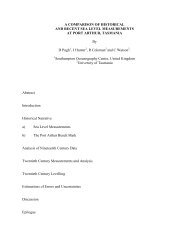Annual report 2005-06.indd - Antarctic Climate and Ecosystems ...
Annual report 2005-06.indd - Antarctic Climate and Ecosystems ...
Annual report 2005-06.indd - Antarctic Climate and Ecosystems ...
You also want an ePaper? Increase the reach of your titles
YUMPU automatically turns print PDFs into web optimized ePapers that Google loves.
ocean control of carbon dioxideCO2-04: Effect of elevated CO 2on phytoplanktonProject leaderSimon Wright, AADProject staffA Davidson, F Scott, P Thomson, R van denEnden, K Westwood, AAD; W Howard, A Moy,ACE; B Griffiths, B Tilbrook, CMAR; G Hallegraeff,UTAS; T Trull, CMAR/UTASProject AimThis project will describe how Southern Oceanphytoplankton <strong>and</strong> microbial communities willchange as atmospheric CO 2concentrationsincrease. The research team will study thelikely changes in phytoplankton species <strong>and</strong>size distribution, in rates of uptake of carbondioxide through photosynthesis, <strong>and</strong> the extentto which CO 2is recycled through the microbialloop or sedimented to the deep ocean. Thisknowledge is vital to predictions of the role ofthe Southern Ocean in absorbing <strong>and</strong> storingCO 2produced through human activity <strong>and</strong> soits role in influencing global carbon budgets.The results will also be important for developingecosystem models that allow assessment ofimpacts of climate change on <strong>Antarctic</strong> marineecosystems <strong>and</strong> provide advice for ecosystembased management of Southern Ocean fisheries,particularly those regulated through CCAMLR.Key achievements in <strong>2005</strong>-06• The distribution <strong>and</strong> carbonate shellcharacteristics of the globally importantphytoplankton Emiliania huxleyi weredetermined from samples collected by theunderway observation program onboard theFrench <strong>Antarctic</strong> resupply ship l’Astrolabe.In comparison to results from the 1980s,E. huxleyi populations showed expansionsouthward all the way to the <strong>Antarctic</strong> seaice, but with lower calcification in southernsamples. This poleward expansion parallelsresults from the Northern Hemisphere <strong>and</strong>may be a response to ocean warming. Thereduced calcification is consistent withexpectations from laboratory experimentson the response to ocean acidificationby anthropogenic CO 2. This complexityof response to global change typifies thedifficulty of ecosystem predictions <strong>and</strong> alsothe occurrence of transient states as thesystem evolves.• Initiation of a study of the genetic diversityof E. huxleyi phytoplankton as the next stepin underst<strong>and</strong>ing their response to oceanacidification.• Award of research funds from the AustralianGreenhouse Office to initiate a study intothe links between ocean acidity <strong>and</strong> thecarbonate shell compositions of SouthernOcean foraminifera (a globally important typeof amoebic zooplankton).• This project has growing collaborations withour partner agencies, including S Blackburn<strong>and</strong> P Thompson (CMAR) <strong>and</strong> U Bjima (AWI).32 <strong>Antarctic</strong> <strong>Climate</strong> & <strong>Ecosystems</strong> CRC - <strong>Annual</strong> Report <strong>2005</strong>-06








